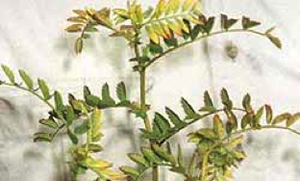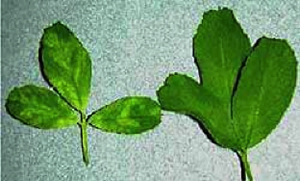Temperate pulse viruses: cucumber mosaic virus
 Cucumber mosaic virus (CMV) causes severe disease in lentils, chickpeas and lupins.
Cucumber mosaic virus (CMV) causes severe disease in lentils, chickpeas and lupins.
In areas where large aphid populations occur, crop losses can be high due to reduced herbage production and grain yield. The virus is transmitted by a number of aphid species as well seed-transmitted in many pulse species.
CMV has the widest host range of any known plant virus and is distributed worldwide. The host range includes a large number of agricultural and horticultural crops including temperate pulses, pasture, forage legumes and weed species.
What to look for
 Symptoms of CMV on temperate pulses and pasture legumes are as follows:
Symptoms of CMV on temperate pulses and pasture legumes are as follows:
- Clover species tend to develop down curling of the leaves and slight stunting.
- Desi chickpeas develop leaf chlorosis, reddening and stunting of the plants.
- Lucerne develops a bright mosaic on the leaves.
- Field peas may develop leaf chlorosis and slight stunting, but generally symptoms are mild and difficult to observe.
- Grass pea (lathyrus) and narbons bean develop a mild mottle and down turning of the leaves.
Kabuli chickpeas develop leaf chlorosis, yellowing of the whole plant and stunting. - Lentils develop chlorosis, leaf distortion and stunting of the plant.
- Lupins develop reduced internodes, bunchy appearance, chlorosis and stunting.
- Symptoms on faba bean vary from symptomless to systemic necrosis and plant death, but symptoms are generally mild and difficult to observe.
Economic importance
CMV is of economic importance in a range of crops worldwide.
In Western Australia, high levels of CMV infection in lupin crops have resulted in subsequent yield losses of up to 60 per cent, leading to the development of integrated management packages to control the disease (Jones, 2000). In Western Australian field experiments, CMV infection in Matilda lentils was shown to diminish shoot dry weight by 72 to 81 per cent, seed yield by 80 to 90 per cent and individual seed weight by 17 to 25 per cent (Latham et al., 2004).
The Victorian DEPI surveyed chickpea, faba bean, field pea and lentil crops in south eastern Australia for CMV from 2000 to 2010. More lentil and lupin crops were found infected with CMV than any other crop type, and the within-crop incidence of the virus was usually higher in these two crops than in the other crops surveyed.
Disease cycle
Transmission
 CMV is transmitted in a non-persistent manner by more than 80 aphid species.
CMV is transmitted in a non-persistent manner by more than 80 aphid species.
The spread of the virus is generally over short distances as aphids only remain infective for periods from a few minutes up to a few hours.
During DEPI of the Wimmera cropping region over a number of years the following aphid vectors of CMV have been found:
- lucerne blue green aphid (Acyrthosiphon kondoi)
- cowpea aphid (Aphis craccivora)
- foxglove aphid (Aulacorthum solani)
- ornate aphid (Myzus ornatus)
- green peach aphid (Myzus persicae)
- cabbage aphid (Brevicoryne brassicae)
- sowthistle green aphid (Hypermyzus lactucae)
- sowthistle brown aphid (Uroleocon sonchi).
CMV is transmitted via seed in a number of host species.
In Victoria, surveys of pulse seed-stock found that 7% of lentil seed samples, and 9% of faba bean seed samples had up to 0.2 per cent and 0.1 per cent CMV infection respectively.
In Western Australia, seed transmission experiments showed seed transmission rates for CMV of up to 1 per cent in lentils, 2 per cent in chickpeas and 0.8 per cent in narbon beans, and for the first time showed that CMV is seed transmitted in field peas and faba beans (Latham and Jones, 2001).
CMV is also seed transmitted in a range of annual pasture and forage legume species at rates of 0.05 to 8.8 per cent.
Host range
The host range of CMV is wide and not restricted to the Fabaceae family.
All pulse crops grown in southern Australia are hosts of CMV. This includes major pulses such as:
- chickpeas
- lentils
- lupins
- field peas
- faba beans.
As well as minor pulse crops such as grass pea (Lathyrus) and narbon beans.
Many pasture and forage legumes grown in the cropping regions, such as lucerne, vetch, medic, annual and perennial clover are also hosts.
During studies in Victoria and South Australia, a number of weed hosts were identified in crops and on roadsides including:
- bifora (Bifora testiculata)
- prickly lettuce (Lactuca serriola)
- common sowthistle (Sonchus oleraceus)
- Indian hedge mustard (Sisymbrium orientale)
- burr medic (Medicago polymorpha)
- snail medic (Medicago scutellata)
- barrel medic (Medicago truncatula).
Table 1. Percentage of pulse crops infected with Cucumber mosaic virus in south eastern Australia and within crop virus incidence
Victoria – Lentil
Year | % of sampled crops infected | Within crop virus incidence range % |
|---|---|---|
2000 | 7 | 1 to 7 |
2001 | 21 | 1 to 4 |
2004 | 26 | 1 to 5 |
2006 | Crop not sampled | Crop not sampled |
2007 | 50 | 5 to 100 |
2009 | Crop not sampled | Crop not sampled |
Victoria – Lupin
Year | % of sampled crops infected | Within crop virus incidence range % |
|---|---|---|
2000 | 25 | 21 |
2001 | 9 | 2 |
2004 | Crop not sampled | Crop not sampled |
2006 | Crop not sampled | Crop not sampled |
2007 | 25 | 9 |
2009 | Crop not sampled | Crop not sampled |
Victoria – Chickpea
Year | % of sampled crops infected | Within crop virus incidence range % |
|---|---|---|
2000 | Virus not found | Virus not found |
2001 | 11 | 1 to 2 |
2004 | Virus not found | Virus not found |
2006 | Crop not sampled | Crop not sampled |
2007 | 60 | 1 to 10 |
2009 | 100 | 1 to 63 |
Victoria – Field pea
Year | % of sampled crops infected | Within crop virus incidence range % |
|---|---|---|
2000 | Virus not found | Virus not found |
2001 | Virus not found | Virus not found |
2004 | Virus not found | Virus not found |
2006 | 30 | 1 to 5 |
2007 | 8 | 1 |
2009 | Crop not sampled | Crop not sampled |
South Australia – Lentil
Year | % of sampled crops infected | Within crop virus incidence range % |
|---|---|---|
2001 | 100 | >22 |
2003 | 83 | 1 to 11 |
2004 | 50 | 4 to 23 |
2005 | Virus not found | Virus not found |
2006 | 80 | 34 to 78 |
2007 | 100 | 4 to 100 |
2009 | Crop not sampled | Crop not sampled |
South Australia – Lupin
Year | % of sampled crops infected | Within crop virus incidence range % |
|---|---|---|
2001 | Crop not sampled | Crop not sampled |
2003 | Crop not sampled | Crop not sampled |
2004 | Crop not sampled | Crop not sampled |
2005 | Crop not sampled | Crop not sampled |
2006 | 88 | 7 to 53 |
2007 | 40 | 25 to 100 |
2009 | Crop not sampled | Crop not sampled |
South Australia – Chickpea
Year | % of sampled crops infected | Within crop virus incidence range % |
|---|---|---|
2001 | Crop not sampled | Crop not sampled |
2003 | 100 | 1 to 4 |
2004 | Crop not sampled | Crop not sampled |
2005 | Crop not sampled | Crop not sampled |
2006 | 100 | 1 to 9 |
2007 | 100 | 3 to 10 |
2009 | 33 | 2 to 9 |
South Australia – Fieldpea
Year | % of sampled crops infected | Within crop virus incidence range % |
|---|---|---|
2001 | Crop not sampled | Crop not sampled |
2003 | 8 | 1 |
2004 | Virus not found | Virus not found |
2005 | Virus not found | Virus not found |
2006 | Virus not found | Virus not found |
2007 | 18 | 2 to 41 |
2009 | Crop not sampled | Crop not sampled |
New South Wales – Lentil
Year | % of sampled crops infected | Within crop virus incidence range % |
|---|---|---|
2009 Northern | Crop not sampled | Crop not sampled |
2009 Southern | Crop not sampled | Crop not sampled |
New South Wales – Lupin
Year | % of sampled crops infected | Within crop virus incidence range % |
|---|---|---|
2009 Northern | Crop not sampled | Crop not sampled |
2009 Southern | Crop not sampled | Crop not sampled |
New South Wales – Chickpea
Year | % of sampled crops infected | Within crop virus incidence range % |
|---|---|---|
2009 Northern | 33 | 1 to 17 |
2009 Southern | 38 | 2 to 16 |
New South Wales – Field pea
Year | % of sampled crops infected | Within crop virus incidence range % |
|---|---|---|
2009 Northern | Crop not sampled | Crop not sampled |
2009 Southern | Crop not sampled | Crop not sampled |
CMV on faba beans was a minor problem. Throughout the surveys the number of faba beans crops infected with CMV never exceed 10 per cent, and within crop CMV infection never exceed 4 per cent.
Management
CMV is spread by sowing infected seed or by movement of aphid vectors from infected plants to healthy plants.
Low levels of seed infection in pulses may lead to the spread of CMV during years with high rainfall and subsequent early build up of large aphid populations. Chemical control of aphids is not an effective method for controlling CMV.
Sowing healthy seed, managing weeds and other cultural practices to minimise CMV spread are recommended.
Growing crops adjacent to infected lucerne or pasture will increase the risk of crop infection.
Some seed companies sell lentil seed, which has been tested for CMV and AMV. Commercial seed testing companies will also test legume seedlots for seed-borne viruses such as CMV. If farmers retain their own seed it should be selected from crops which do not have virus symptoms or evidence of aphids.
Further references
- Pulse Australia
- Victorian crop sowing guide
- Winter Pulse Disorders: The Ute Guide
- Seed health testing in pulse crops
- Virus control in chickpea–special considerations
- Bwye AM, Jones RAC, and Proudlove W (1999) Australian Journal of Agricultural Research 50, 985-996.
- Bwye AM, Proudlove W, Berlandier FA and Jones RAC (1997) Australian Journal of Experimental Agriculture 37, 93-102.
- Jones RAC (2000) Virus Research 71, 171-183.
- Jones RAC, Coutts BA, (1996) Annals of Applied Biology129, 491-506.
- Jones RAC, Coutts B and Kehoe M (2010) CMV in Lupins. Farm Note No 402. DAFWA.
- Latham LJ, Jones RAC (2001) Australian Journal of Agricultural Research 52, 397-413.
- Latham LJ, Jones RAC, Coutts BA (2004) Australian Journal of Agricultural Research 44, 57-63.
- Latham LJ, Jones RAC, McKirdy SJ (2001) Australian Journal of Agricultural Research 52, 683-697
Contact
Dr Piotr Trebicki
Virologist – Horsham
03 5450 8301
Field Crops Pathology
Grains Innovation Park
110 Natimuk Rd
Horsham 3400
03 5450 8301
Or call the Customer Service Centre, 136 186
Acknowledgments
Mohammad Aftab, Angela Freeman, Frank Henry. Support by the Grains Research and Development Corporation is gratefully acknowledged.